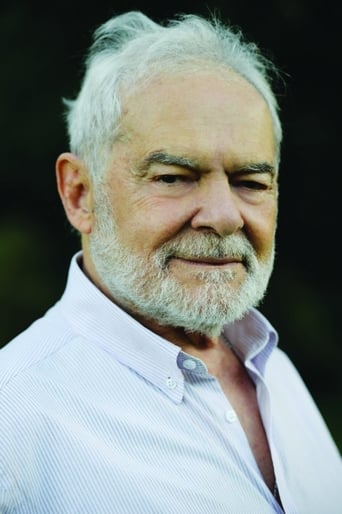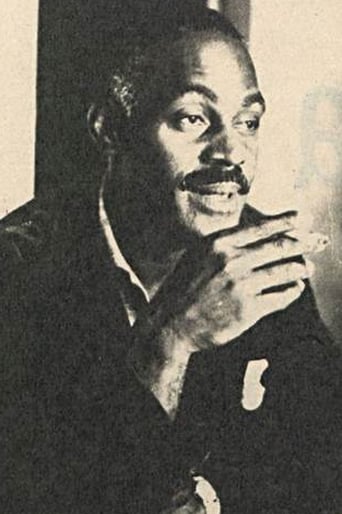BootDigest
Such a frustrating disappointment
StyleSk8r
At first rather annoying in its heavy emphasis on reenactments, this movie ultimately proves fascinating, simply because the complicated, highly dramatic tale it tells still almost defies belief.
Geraldine
The story, direction, characters, and writing/dialogue is akin to taking a tranquilizer shot to the neck, but everything else was so well done.
tomgillespie2002
At just 25, Brazilian director Glauber Rocha directed Black God, White Devil, now considered one of the most important pictures to ever come out of Brazil, and a key entry into the Cinema Novo movement. Combining elements of Sergio Leone, Italian neo-realism, and Soviet propaganda such as the work of Sergei Eisenstein, Rocha created a brutal, grainy world inhabited by suicidal religious fanatics, wandering hit men, and psychopathic bandits. From the opening shots of rotting animal corpses and the endless Brazilian sertão, Rocha portrays a grim social realism, one of the key aspects of Cinema Novo.Ranch-hand Manuel (Geraldo Del Rey) lives in poverty with his wife Rosa (Yona Magalhaes). Fed up with his situation, he goes into town to sell his stock, only to have his boss try to cheat him out of his money, so Manuel kills him with a machete. Fleeing the authorities, he falls in with maniacal preacher Sebastiao (Lidio Silva), who leads Manuel, Rosa and his other followers on a killing spree. Circumstances lead to Manuel leaving the cause, and joining up with famous bandit Corisco (Othon Bastos), who also leads the couple on an orgy of meaningless violence and thievery. But shadowy gun-for-hire Antonio das Mortes (Mauricio do Valle), having been paid by the church and a poltician, is hot on Corisco's tail.The film very much reminded me of Cormac McCarthy's astounding novel Blood Meridian, where the sheer brutality of the violence played as a metaphor for a society gone sour and a world intent of self-destruction. Like Blood Meridian's The Kid, Manuel and Rosa follow blindly to whichever cause they see a glimmer of hope in. They fail to see the lunacy of Sebastiao's behaviour, and it's only at the point where he stabs a baby in the heart that their eyes seem to be opened, only for them to shack up with the gibbering Corisco, a man who speaks like a poet but doesn't seem to be able to comprehend his own existence. It is at this point, about two-thirds in, that the film seems to lose momentum and becomes somewhat of an unfathomable mess.But it isn't just the social-political ponderings that make Black God, White Devil so memorable, it also has style in abundance. The camera-work is shaky and urgent at times, full of character close-ups from awkward angles, but it also uses fast editing reminiscent of Eisenstein's greatest works. Similar to Battleship Potemkin's (1925) Odessa steps sequence, the Monte Santo chapel massacre at the hands of Antonio das Mortes is simply electrifying. It is das Mortes' presence that leads to the moments that evoke the work of Sergio Leone, wrapping the shady anti-hero in moody atmosphere like Clint Eastwood's Man With No Name. It's a dangerous mixture of conflicting styles that works beautifully, making the film beautiful and cool, occasionally horrifying, and undoubtedly important. It's just a shame it doesn't manage to keep up with the absolutely astonishing opening two-thirds.
debblyst
"So I've told you a story/of truth and imagination/I hope you've learned the lesson/and see this world is unjustly divided/for the land belongs to man/not to God nor to the Devil". Thus sings the narrator of Glauber Rocha's astonishing, symphonic, revolutionary epic masterpiece that changed Brazilian cinema overnight, was enthusiastically praised by great international filmmakers (Buñuel, Pasolini, Bertolucci, Godard, Leone) and stormed Cannes in 1964. Glauber, just 23 at the time of filming, combines a wide range of influences (Eisenstein, Dovzhenko, Humberto Mauro, John Ford, Welles, Rossellini, cinema-vérité, Godard, Buñuel, Brecht, Marx, Frantz Fanon, Guimarães Rosa, José Lins do Rego, Euclides da Cunha, Villa- Lobos, Portinari, Brazilian Art Brut and Northeastern popular culture) to achieve a poetic, explosive, entirely unique style that bombards the screen with unforgettable images, sounds and political significance."Truth and imagination" are the keywords to the film. Inspired by actual events ("truth") raised to almost mythological heights ("imagination") by Brazilian pamphlet literature ("literatura de cordel") and folklore, the film follows poor peasant cowherd Manuel and his wife Rosa in their dire saga through the Brazilian "sertão" (the arid hinterland in the Northeast of Brazil), and their encounters with "God" -- personified by black prophet Beato Sebastião (who turns out to be a messianic madman) -- and the many "Devils", personified by "Blond Devil" Corisco, the very last of the "cangaceiros" (heavily armed bandits who terrorized the "sertão" and became popular anti-heroes, not unlike U.S. Wild West bandits); Antonio das Mortes, the mercenary headhunter hired by local politicians and priests to kill Corisco; and Moraes, the cattle owner who, by humiliating Manuel, finally brings forth Manuel's tempestuous reaction and subsequent journey into crime, religious fanaticism, tragedy and final enlightenment.The highlights are countless: the film's opening shots, with the fly-infested carcasses of dead cows and horses out of thirst and famine under the blazing sun; the slow-paced depiction of Manuel+Rosa's lives in abject poverty, their hard and repetitive work, their endless struggle against hunger and inclement weather; the extraordinarily inventive sung narration, in the style of the "cantadores" (minstrels) of the "sertão", setting all the action in motion and commenting on it; the electrifying montage of the Monte Santo massacre, a tribute to Einsenstein's iconic Odessa steps scene in "Potemkim", and just as riveting; the Monte Santo chapel sequence, as Manuel kills an innocent baby in ritual sacrifice only to suddenly realize the horror of blind religious fanaticism; Beato Sebastião, fatally stabbed by Rosa, deliriously crawling on the altar's big crucifix as he tries to place himself on the cross as a new Messiah; the expressionist scene where the shadows of Rosa's knife and Antonio das Mortes' rifle "touch" on the chapel wall, marking the birth of a new, doomed pact of blood and death; Villa-Lobos' famous Bachianas #5 vocalise dictating the pace of Corisco+Rosa's passionate kiss while the camera draws frantic circles around them; the Buñuelian power of the sequence where the wedding party turns into a nightmarish terror of merciless torture and rape.There's much more: Othon Bastos's amazing performance as Corisco, with his electric, restless body movements and thunderous voice ("Corisco" means lightning in Portuguese). There's a staggeringly bold conception in the scene -- partly influenced by Kurosawa's Rashomon and partly by the trance tradition of Afro-Brazilian religions -- where Corisco suddenly "incorporates" the spirit of dead bandit Lampião, aka the "king of the cangaceiros": Bastos' voice lowers, his gestures become hieratic, the camera frames just half of his head in extreme close-up (the "split" personality), alternating with close-ups of the emblematic elements of his "cangaceiro" outfit, where bullets, crucifixes, silver coins, guns and amulets co-exist, representing religious faith, ostentation, superstition, vanity and thirst for blood. Observe the way Glauber "arranges" his characters on screen: they always move "magnetically" toward other characters with whom they identify at given moments; it's a Brechtian, choreographic mise-en-scène in a completely non-theatrical environment (the vast openness of the sertão!). Waldemar Lima's weightless, dizzying camera and high-contrast lighting is essential to the film's aesthetics, as is Sérgio Ricardo's voice and guitar-playing as the narrating minstrel, Rafael Valverde's virtuoso, multi-style editing and the unique locations in the hinterland of Bahia.I could go on and on; it's such a rich film that multiple viewings are required, culminating in the breathtaking finale of unforgettable poetic and political impact. Building a realist/expressionist/ mythological portrayal of Brazilian sertão -- the inhuman labor and life condition of the illiterate, destitute, God-fearing peasants, perennially exploited by landowners, politicians, bandits, Catholic priests and doomsday messianic "prophets" -- Glauber proposed a "new Brazilian cinema" for a new Brazil, less ignorant, less corrupt, less unequal, less exploitative. A country where land could finally belong to Man, not to God nor to the Devil. Rocha's ambitious dream was traumatically excised by the Brazilian military coup of 1964, that buried all hopes of a long-awaited and much-hailed political and agrarian reform that ultimately caused the deposition (with the CIA's active help) of left-wing President João Goulart. But this incendiary, revolutionary, poetic manifesto influenced a whole generation and is still dazzling enough to keep inspiring filmmakers and audiences whose blood boils for socially-aware films that are also non-conformist works of art. A masterpiece.
dbaltz2003
I'm very pleased to comment this picture. It treats about all the hard life of Brazil's northeast population in 60's. Every person should have this knowledge, to understand why Brazil's people are so strong. Even if many people didn't understand, the picture is very realist.It's the fight for life in a place where there is no hope, unless you make justice with your own hands. There is a significant way of showing how poor people survive in extreme conditions of weather. Another thing that it should be said about this wonderful movie is that there is no political structure able to stop life, as it is demonstrated in the scenes of the movie.This is a movie to anyone who wants to have a better idea about real life.
cybermorphy
Deus e o Diabo na Terra do Sol isn't just a good Brazilian movie. This is an actual masterpiece, compared to the big ones in the history of cinema. It's not a boring and too regional film, but deals with universal aspects of human nature, such as blind devotion, love, hate, and all kinds of misery. Glauber Rocha, with only 22 years, made a mix of Eisenstein, Italian neo-realism and nouvelle-vague, under a background of cordel literature (our pulp fictions). The Mauricio do Valle character, Antonio das Mortes, is fundamentally a European western anti-hero, and certainly inspired Leone, Corbucci and others in the development of their scripts. The soundtrack, with Villa Lobbos and Rocha&Ricardo songs, matches perfectly with the dry landscape of the Brazilian Northeast. In short, Deus e o Diabo na Terra do Sol must be known. If you have open mind and like great cinema, and not just the popcorn no-brain north-American blockbusters, try this one.





